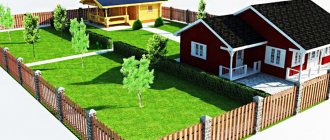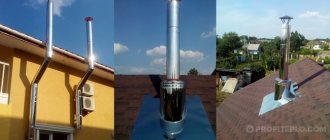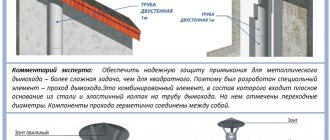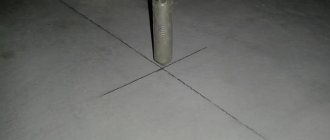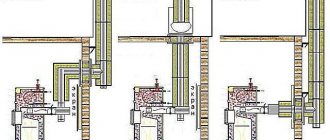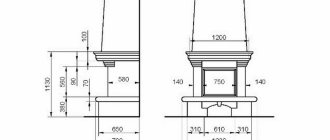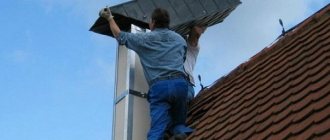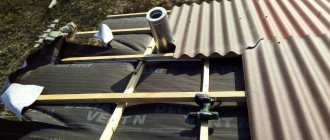Pay maximum attention to this element of the heating system
Installing a chimney in a wooden house with your own hands - conventional and coaxial
We will now try to establish the differences between these chimneys, find out how they are installed, and in addition, we will give you the opportunity to watch the video in this article.
Various chimneys
Important! When calculating how to install a chimney through a wooden ceiling, it is important to remember that at 200 ⁰C the charring of wood begins, and a temperature of 300 ⁰C allows you to maintain stable combustion of wood in the stove firebox. This suggests that the main efforts should be directed at reducing the temperature at the junction of the pipe.
Installation specifications
Can use ceramics
- In order to ensure the correct installation of a chimney in a wooden house, you do not have to “create a bicycle” - there is practical experience, which is currently reflected in the form of regulations in various government documents. You can obtain the basic installation manual from SNiP 41-01-2003 (heating, ventilation and air conditioning) - it contains basic information that will be taken into account by fire safety representatives during inspection.
- But the constant temperature in the chimney can also depend on the distance of one or another section of it from the firebox, which is influenced by the design of the heater itself and the design of the chimney system. According to SNiP 41-01-2003, you need to maintain certain distances from stoves and pipes to flammable objects - in this case, it is wood (walls, partitions, rafters, etc.). Thus, brick and concrete stoves or pipes should be located at a distance of 130 mm, and metal and ceramics - 250 mm from lumber structures.
| Type of equipment | Heating temperature |
| Fireplace or Russian stove (wood) | 350-650⁰C |
| Stove in the bathhouse (wood) | 400-700⁰C |
| Gas generator boilers (wood) | 160-250⁰C |
| Solid fuel boiler (pellets) | 120-250⁰C |
| Solid fuel boiler (sawdust) | 220-240⁰C |
| A gas boiler | 120-200⁰C |
| Liquid fuel boiler | 150-250⁰C |
| Solid fuel boiler (coal) | 500-700⁰C |
Heating table for chimney pipes with different heaters
Attention! The same standards apply to fusible insulation materials such as polystyrene foam, expanded polystyrene, and so on. When installing pipes, try to remove the insulation to the specified distance.
Brick pipes
Exit section in a multi-storey wooden house: 1 – channel for smoke; 2 – floor beam; 3 – cutting into one and a half bricks; 4 – asbestos sheet in 2 layers; 5 – cutting into one brick with insulation; 6 – casing
The construction market is constantly offering more and more new materials from which pipes for chimneys are made, but, nevertheless, brick always remains the main material for arranging the channel itself or its insulation.
When passing a chimney through a wooden ceiling with your own hands, it is important to observe some nuances of the masonry - it is laid on lime or cement-lime mortar up to the roof.
But for the part that rises above the roof, you already need to use a cement-sand mortar - there the temperature of the passage drops sharply. The seam on the brickwork should not be wider than 10 mm, otherwise the structure will lose rigidity and stability, but there is simply no point in strengthening or simply lining the chimney with plaster - it will still crack from temperature changes and collapse.
It is recommended to build such structures from solid single red brick, the weight of which is on average 3.45 kg, therefore, the entire masonry will be very heavy. This indicates that a solid foundation is needed - it should be not only under the stove, but also under the walls of the house, since, starting from the sunbed, the entire mass of the smoke channel rests on the ceiling, which, in turn, rests on the walls.
Brickwork as insulation
As a rule, when building brickwork, everyone tries to make its front side as smooth as possible, but the uneven surface inside the pipe contributes to the very rapid settling and accumulation of soot on the walls, and this already carries the risk of fire.
In addition, the brick or mortar sticking out from the inside is destroyed under the influence of acidic condensation, and the pieces that fall inside block the passage, thereby reducing the cross-section of the channel, and the draft becomes worse.
Note. If your brickwork is made as a sleeve, the chimney itself consists of an asbestos-cement or metal pipe, then you can fill the free space with sand-cement mortar or fine-grained concrete (this is called a sleeve - this increases not only the price of the structure, but also its quality). This way you will not only enhance thermal insulation, but also prevent premature destruction of asbestos cement.
Ceiling and wall
Installation of thermal insulation in the ceiling
As you understand, the distance from the chimney to wooden structures according to SNiP 41-01-2003 is given in open space, but passage through the ceiling is carried out according to different standards, since in such cases various insulating materials are used that reduce the heat transfer of the chimney.
For example, if, when passing a metal or asbestos-cement pipe through a wooden floor, two layers of asbestos sheet are used, then the distance of one brick should be maintained, that is, 250 mm, but if such a heat extinguisher does not exist, then this distance will increase to 380 mm. (See also the article Insulation of wooden floors: features.)
In the photo, brickwork and galvanized sheet are used as thermal insulation.
The requirements for the distance between the chimney and the wall remain exactly the same as for floors, that is, if there is two-layer asbestos insulation, then it must be at least 250 mm, and if there is none, then it increases to 380 mm.
But sometimes such requirements can be waived a little, for example, the distance can be made a few centimeters smaller at the boiler in the steam room, since it operates periodically, however, so that the lining does not burn, it is sheathed with galvanized sheeting, as shown in the top photo.
Height requirements
When installing a chimney directly through a ridge, its height to the cap must be at least 200 mm. In cases where the pipe is located to the side, on a slope, it should be at least 500 mm higher than the ridge. This will ensure normal traction.
Coaxial chimney
When a coaxial chimney is installed in a wooden house, there are completely different requirements that do not require maintaining a distance from flammable objects, since the pipe simply does not heat up. It's all about the design of this device - gases from combustion products are vented outside through an internal pipe, and through the sleeve (outer pipe) air from the street enters the boiler, supplying the oxygen necessary for combustion. (See also the article Attic flooring on wooden beams: features.)
In cases where a gas boiler has forced circulation, the “coaxial” (output) is installed only in a horizontal position. With natural circulation, pipes can be installed vertically or inclined.
What materials can be used for fire protection when installing polyurethane foam?
Both brick, ceramic, and metal parts of interfloor cutting units are heated to temperatures that create a risk of wood fire. To reliably isolate the flammable elements of the ceiling pie, you need to make a gasket made of protective materials.
| Material | Description |
| Slab fireproof material based on cement with the addition of limestone, mica and cellulose. Withstands constant heating up to 150 °C. When exposed to higher temperatures, the organic mineralite filler burns out and it becomes brittle. | |
| This general name refers to fibrous insulation, consisting of molten threads of various inorganic natures. This can be either minerals (basalt, dolomite, etc.), or blast furnace waste, slag. Slag wool does not lose its properties up to temperatures of 300°C; in a hotter environment, sintering of the fibers occurs - binders and water-repellent additives are not as resistant to fire as the mineral component. As a result, thermal conductivity increases sharply. Rigid mineral board of the PZh-175 brand is positioned as a fire-resistant material. It is capable of maintaining insulating properties up to 1000°C. | |
| Available in thicknesses from 2 to 10 mm. This is a material that perfectly protects against fire; it not only does not burn, but also does not smolder. Harmfulness may be considered a limitation on its use - asbestos vapors are undesirable in a bathhouse. All asbestos gaskets on the steam room side must be covered with metal. | |
| A highly efficient and absolutely environmentally friendly heat insulator, which belongs to the group of non-combustible materials. Its thickness is 5 mm, the thermal conductivity coefficient increases slightly with increasing temperature, and it operates reliably at temperatures up to 900°C. |
These are materials that can protect wooden parts from charring and fire at high temperatures in a high-heat zone. But the primary cladding of the ends of the floor, if the necessary indents are observed, can be carried out not only by them. For these purposes, it is allowed to use materials with flammability class G1 (low flammability).
| Material | Description |
| It has the designation GKLO, gray sheets with red markings. It differs from the usual one by the presence of internal reinforcement with a tighter adhesion of the layers. This prevents the penetration of oxygen into the thickness of the material, combustion is not supported and even in an open fire the material does not collapse within 20 minutes. | |
| Only products labeled as Premium class have fireproof properties of the NG degree. A sheet of the Standard class, which is not marked in any way, cannot be used to protect wood. |
The choice of thermal insulator can play a decisive role. It should be remembered that ordinary mineral wool, which is sometimes recommended to be used for filling the passage unit, sinteres when heated and quickly loses its fire-retardant properties.
High temperature leads to a change in its structure - while remaining unchanged in appearance, it can heat up significantly and can no longer cope with thermal insulation. To ensure reliable thermal insulation of the chimney, it is necessary to use basalt wool, designed for operation at temperatures of 800-1000°C.
It is also safe to lay mineralite, asbestos or basalt cardboard. There is also a time-tested budget option for thermal protection - sand was used for it (the passage box was filled with it) and clay. For example, sufficient thermal insulation of the part of the ceiling to which the box is attached is achieved by applying an even layer of clay about 2 cm thick to a metal sheet with a flange.
The main tasks that the builder faces when arranging the passage of a chimney through the ceiling of a bathhouse are fire protection for the ceiling and an even vertical installation of the pipe. The work takes place in three stages:
- determination and arrangement of the location of the cutting unit;
installation of a ready-made or self-made protective casing;
final thermal protection gasket.
These are general rules, and specific methods of work depend on many factors - the allocated budget, preferences in the choice of materials, even whether the technologies were followed during the construction of the bathhouse.
Technical prerequisites for selection
If you plan to install a chimney in a wooden house, then before you start installation, you need to find out what is the temperature of the exhaust gases in the heating device in your house? Table 1 shows the flue gas temperature depending on the type of heating device and the fuel used.
People have been living in wooden houses for thousands of years and using stoves, hearths and fireplaces, and have developed considerable experience during this time. This experience is collected in regulations on construction, installation and fire safety. A chimney is being installed in a wooden house in accordance with regulatory documents adopted by government agencies.
There is a guideline document SNiP 41-01-2003 “Heating, ventilation and air conditioning”. It is this document that governs state regulatory authorities.
SNiP states that it is prohibited to place flammable elements closer than 130 mm in the clear distance from concrete and brick pipes or ceramic pipes in thermal insulation. For ceramic chimney pipes without thermal insulation, this distance should be even greater - 250 mm.
Wood is a flammable material; most modern insulation materials are also flammable, and polymer vapor and waterproofing films are even more so. Therefore, we must ensure that these materials do not touch our chimney.
Why comply with them?
Many people do not pay attention to how the passage is made through the interfloor material and the roof. It doesn’t burn out, doesn’t spark – and that’s fine. But, under certain circumstances, failure to comply with certain standards can easily lead to a fire. Also, inconsistency of installation parameters will cause problems when passing a fire inspection.
Problems may also arise when the heating boiler starts working. An incorrectly installed and assembled smoke outlet will be ineffective. “Draft overturning” occurs, which leads to the appearance of smoke in the room.
There is also a certain ratio of draft force to stove power, which allows you to heat the house with maximum efficiency. If the draft is weak, combustion in the stove will be poor, with a lot of smoke, and too strong draft leads to rapid combustion of fuel and a decrease in the efficiency of the stove.
Brick chimney
Despite the mass of new materials for making chimneys, brick still remains quite popular and in demand.
Let us remind you that:
- The pipe should be laid with a bandage, inside the house using lime or cement-lime mortar, and cement mortar is used above the roof.
- According to the “Rules for Pipe and Stove Works”, chimneys must be made of solid red brick, the seam no thicker than 10 mm. It is prohibited to plaster the inner surface of the pipe.
- Serious weight requires a foundation.
- Brickwork is destroyed by acid condensate, brick fragments can collapse inward and narrow the cross-section of the channel.
- Due to the roughness of the brick, soot accumulates inside the chimney pipe.
To reduce the negative aspects, the installation of a brick chimney is carried out as follows: an asbestos-cement pipe is inserted into the smoke channel and the space between it and the brick is filled with concrete. This event is called gilzovka.
The figure below shows the passage of a chimney through a wooden ceiling. On the left is a passage device using 2 layers of asbestos, then the distance from the pipe to the wooden floor beam is 1 brick, that is, 250 mm. And on the right is shown an option without asbestos, in which case the distance from the chimney to the wooden floor beam should be no less than 1.5 bricks, that is, 380 mm.
Rice. 1. Cutting the chimney passage in the interfloor ceiling: 1 chimney; 2 wooden beam; 3 cutting with a thickness of one and a half bricks; 4 double layer of asbestos; 5 cutting the width of a brick with asbestos insulation.
Connection to a wooden wall.
- The wooden wall must be insulated from the chimney; the distance from the “smoke” to the tree must be at least 25 cm. If there is no asbestos insulation, then this distance should be no less than 38 cm. This retreat can be closed with quarter-brick walls on the sides.
- In new log houses, it is customary to install a plank board attached to the wall on a sliding fit to compensate for the inevitable settlement of the log house. And the side closing wall should be adjacent to the quarter in this shield
- Holes are made in the side walls for air circulation. Up and down.
- Wooden setback floors are covered with one row of bricks, tiles or other fireproof materials.
A very important question: how to remove the chimney through the roof? A correctly organized chimney passage through the roof is shown in Fig. 2.
- When planning to bring the pipe through the ceiling, you should make sure that the distance between the outer surface of the brick pipe and the wooden rafters is regulated at least 130 mm.
- This space is filled with stone (basalt) wool, made without an organic binder.
- If the roofing was installed from flammable materials, such as roofing felt, the distance should be doubled to 260 mm.
- In the place where it is planned to remove the chimney, the roof is covered with fireproof materials, for example slate, or better yet roofing steel, at a distance of at least 500 mm from the pipe and the pipes are carefully adjusted to fit the otter.
Rice. 2. passage through the roof
The figure below shows a general diagram of the height of the pipe above the pitched roof.
The height of the chimney above the roof is taken as follows:
- not less than 500 mm when located near the ridge of a pitched roof or in the case of a flat roof;
- not less than 500 mm above the ridge of the roof when the distance of the pipe axis is less than 1500 mm from the parapet or ridge;
- not lower than the ridge of the roof when the chimney axis exits from 1500 to 3000 mm from the ridge;
- not lower than an imaginary line drawn down from the ridge at an angle of 10° to the horizontal, when the chimney axis exits more than 3000 mm from the ridge.
Elevation of the chimney above the roof.
Stove in a bathhouse: features
In the vast majority of cases, this is a wood-burning, cast-iron or steel structure, often equipped with a water heater. Sometimes the product is covered with stone, but usually they do without such covering: the body and pipe in this case also act as heating elements.
The most common type of chimney pipe is steel. Firstly, the material is quite resistant to chemically aggressive substances. Secondly, it is relatively light in weight. And thirdly, the high thermal conductivity of the metal in the steam room is an advantage: the heat from the chimney goes to maintain a high temperature in the room or is used to heat the water in the tank.
However, this same property is also the main disadvantage: the pipe becomes so hot that there is a danger of ignition. Even placing the smoke exhaust duct too close to a wooden wall significantly increases the risk of fire.
The location where the smoke exhaust duct passes through the ceiling must be selected and marked in the design. This greatly simplifies the work, as it allows you to pre-cut a hole of the required size.
When arranging a chimney, you must follow a few more rules.
The passage of the pipe through the ceiling should not only not affect the supporting structures, but also be at a certain distance from them: the minimum distance of the chimney from the supporting ceiling beam or wall is 13 cm.
Ceramic chimneys
In recent years, a chimney in a wooden house is often made of ceramics (see Ceramic pipes for chimneys):
- This is actually a modular system, installation is carried out from prefabricated elements of complete factory readiness.
- Inner tube made of heat-resistant, durable and acid-resistant ceramic.
- Due to the smoothness of the inner surface of ceramic pipes, soot does not accumulate on them and there is no turbulence in the draft flow.
- Due to the significant weight of the chimney system, installation of a foundation is required.
Scheme of a ceramic chimney.
What should be the distance from the chimney to the tree?
It is very difficult to answer this question unambiguously, because everything depends, among other things, on the type of chimney system. In this article, we used data that is suitable for stoves burning solid fuels (wood, fuel briquettes, coal, etc.).
There are three main types of chimney systems - single-circuit metal chimneys, sandwich chimneys and ceramic ones. Each of them has its own rules regarding the distance of the chimney pipe from combustible structures.
Metal chimneys
Chimneys made from sandwich pipes (see Sandwich pipe for chimney) have gained well-deserved popularity:
- Convenient and quick installation.
- Lightweight structures do not require a separate foundation and do not require a foundation.
- Filling with mineral (basalt) wool of the required thickness provides the necessary thermal insulation.
- The smoothness of the inner walls does not allow soot to accumulate and does not disrupt the draft air flow.
- The pipe has a complex structure; an acid-resistant grade of stainless steel is used for the internal channel, this guarantees the durability and safety of the smoke removal system.
Scheme of a sandwich pipe.
When choosing a chimney, you should not forget about the flue gas temperatures shown in Table 1.
Therefore, the thickness of the internal stainless wall of the pipe should be:
- from 0.5 mm for gas, diesel and pellet boilers;
- from 0.8 to 1.0 mm for stoves, sauna stoves and fireplaces;
- from 1.0 mm for coal boilers.
The thickness of the thermal insulation layer should be up to 100 mm in the case of stoves, fireplaces and coal boilers, and in the case of automated boilers the layer thickness should be up to 50 mm.
Overlap
I repeat once again that an undoubted convenience is the availability of ready-made elements for all occasions. If one supplier does not have it, then we can easily find another supplier who can supply all the necessary kit.
- In the case of interfloor slabs, we take ready-made factory-made cutting.
- This cutting is called attic or interfloor.
- The inner diameter must match the outer diameter of the sandwich pipe.
- We cut out a square hole between the beams, corresponding to the size of the square part of the cutting; you can make a reserve to wrap the metal with another 1-2 layers of non-flammable basalt cloth.
- We pass the chimney through the round hole.
- Filling the space with basalt wool
Mounted cutting. The space between the pipe and the metal wall is also filled with mineral wool.
Roof
The problem of how to install a chimney through the roof is solved in much the same way as in the case of overlapping. We take ready-made elements, in particular ready-made roof trim, some call it roof trim. They come in different sizes and with different slope angles.
- Installing a roof passage unit is still much more difficult than installing a floor passage unit.
- The distance from the pipe to the tree must be at least 250 mm on each side. The hole and chimney are covered from above with a special element - a roof.
- This roof is inserted from above under slate or tiles, and from below is placed on top of the tiles.
- On top of the roof, a kopinik is put on the chimney pipe and clamped with a clamp. This provides protection from precipitation.
- The space between the chimney and the rafters is filled with non-flammable mineral (basalt) wool and covered from below with a metal reflector.
Passage through the roof.
Passage through the wall
Often, sandwich-style pipes are led outside the house and run along the outer wall. This has its positive aspects in that there is no need to carry out labor-intensive passages through the floors and roof. And the fire hazard is reduced. In this case, a horizontal passage is added through a vertical wall (see How to route a chimney through a wall).
From the point of view of thermal insulation, this node for passing through the wall is no different from the node for passing through the interfloor ceiling. The installation is complicated only by the fact that the log wall can shrink. And here there should be a sliding fit of the cutting.
Do-it-yourself cutting for a chimney
- tin for making cutting boxes;
- stainless steel sheet;
sheet of gypsum board or basalt cardboard;
The material for filling the box is expanded clay, but dry clay can also be used.
The pipe passage in this example is carried out at the stage before finishing the ceiling. This is not important; the sequence of operations does not change.
| Illustration | Description |
| A tin box is made - a board is taken as a template for the folds, the edges are fastened with rivets. The dimensions of the box correspond to the distance between the ceiling beams, if their location was thought out taking into account the future installation of the chimney. The indentations are calculated according to the standards, 380 * 2 the diameter of the inner pipe of the sandwich. | |
| Using a plumb line, the center of the pipe is determined. A point is marked where the weight dropped from the ceiling hits the center of the hole for the pipe. This will be the center of the chimney and the floor passage unit. A hole is cut above the pipe. When marking it, the mineralite layer that runs along the perimeter is taken into account. After laying it, the box should sit freely on the ceiling. The ends of the hole are laid with strips of mineralite; it is enough to provide thermal insulation along the edge, where the metal will come into contact with the ceiling structure. | |
| The tin box does not have sufficient rigidity, and to maintain its shape, galvanized profile spacers are installed. | |
| A stainless steel sheet is cut. Before removing the protective film, fix the exact location of the hole for the pipe. The cutout diameter leaves a gap between the pipe and the hole. Additionally, a decorative shield is prepared from the same material, which will cover the joint. Using metal scissors, carefully cut out the center of the resulting circle in sectors. | |
| Start cutting the heat-insulating gasket under the sheet. The template for it is a ready-made sheet of metal. The tools you will need are a jigsaw. Insert the box into place and cover the hole with a stainless steel sheet. To make sure that the ceiling in the area adjacent to the box will not char or catch fire, this is done through a thermal protection sheet. The decorative overlay is attached to the sheet. As a result, a reliable and beautiful screen is obtained above the stove near the chimney. |
The bathhouse is a wooden structure, which means it is extremely fire hazardous. Therefore, special attention should be paid to the issue of competent implementation of ceiling cutting - leading the chimney through the ceilings between floors or onto the roof.
